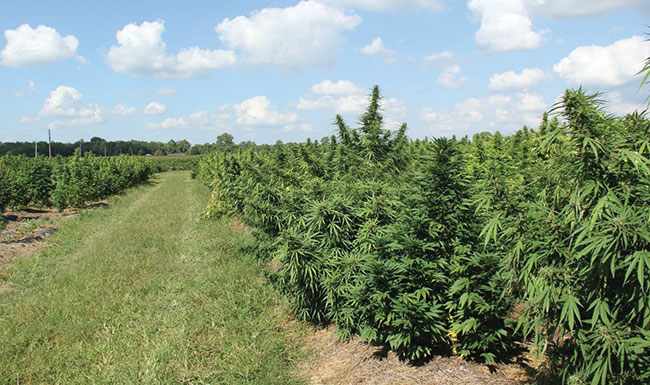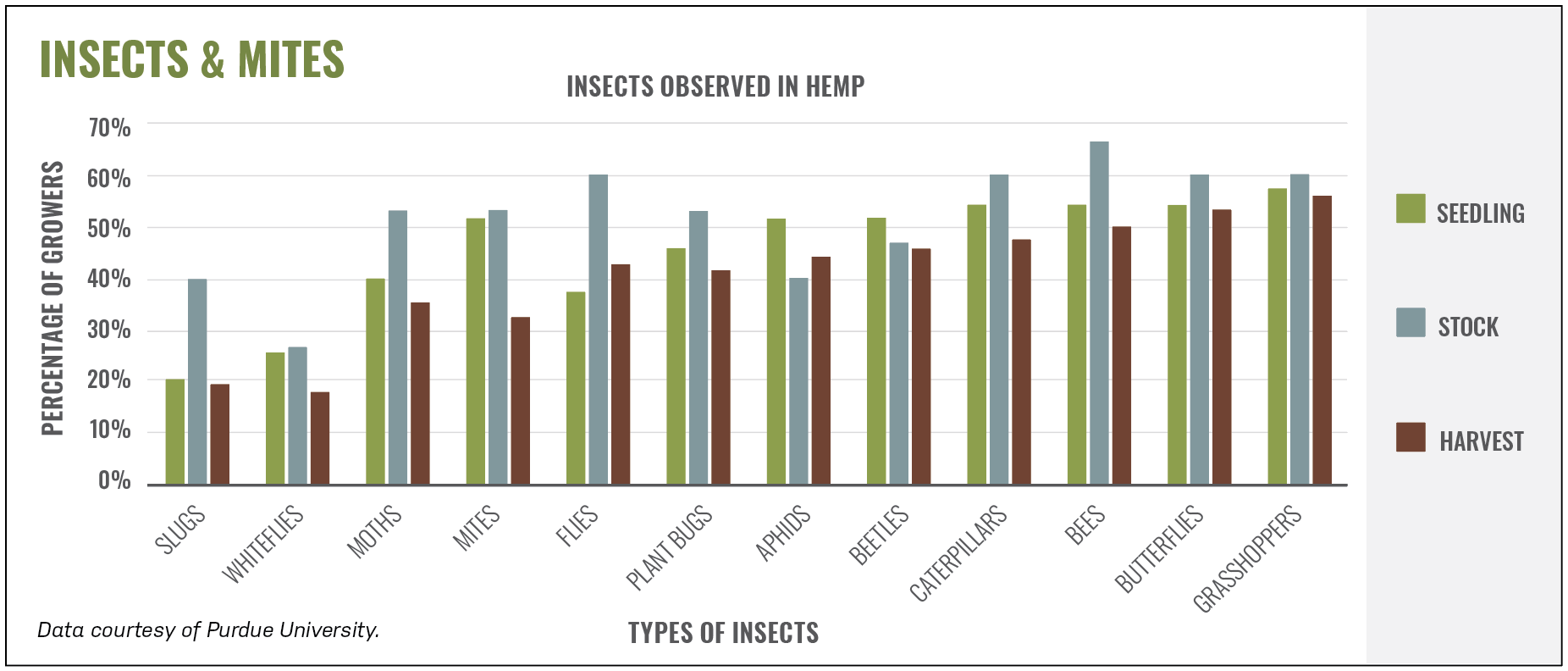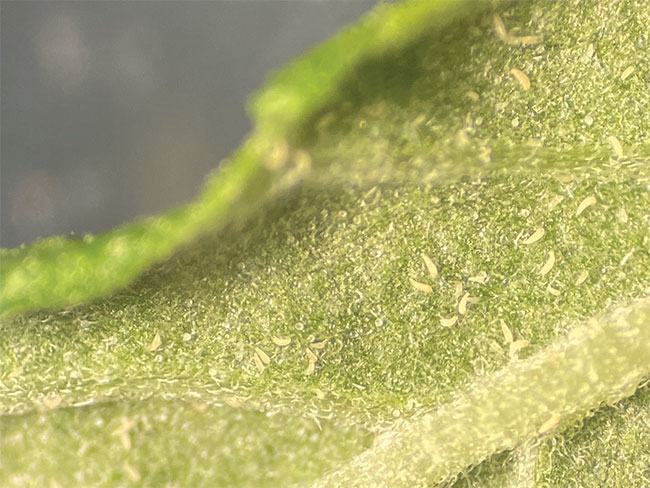
Advice for healthy hemp
Hemp is a relatively new commercial crop and growers throughout the country continue to develop best practices for indoor and outdoor growing.
Marguerite Bolt grew up on a specialty crop farm, has a bachelor’s in entomology and conducted research in hemp-insect interactions while earning her masters degrees in entomology as well. She is now pursuing her Ph.D. in agronomy and is the hemp Extension specialist in the Department of Agronomy at Purdue University.

Purdue conducted a survey about hemp with growers in Illinois, Indiana, Michigan, Ohio, Oregon and Wisconsin in 2021. While some of the management difficulties were found to be insects, weeds and diseases, weeds were the biggest pests to control that created actual yield loss for outdoor growers. Indoor growers experienced more challenges with insects and diseases.
Major growing pains
Poor site selection is one of the challenges new hemp growers face. “This is really more pertinent to outdoor growers, but we have seen challenges in fields that have been set in low lying areas and really heavy soil types that are compacted,” said Bolt. Poor site selection affects productivity and can lead to crop loss.
Obviously, too little or too much water can cause issues for any grower. “I’ve seen this in indoor and outdoor grows where [growers are] not timing their watering properly, or they’re fertigating — they have fertilizers dissolved in their irrigation — and they’re getting salt accumulation in their propagation blocks,” said Bolt. “And they’re seeing some plant loss there and some root death.”

Pot size being too small is another issue we’ve seen too, said Bolt. Growers aren’t moving plants into larger pots early enough so they’re getting a lot of girdling and root binding; and then those plants decline pretty rapidly.
Fertility problems can happen easily because it’s not just about fertilizing enough. Issues with roots, pathogens and insects become more common when plants are fertilized too much, said Bolt.
“So just kind of finding that sweet spot with fertility, which again can be challenging because different plants have different needs throughout the life cycle,” she said. Timing and understanding what nutrients the plant needs, and when, is really important to reduce crop losses.
Pests
Allowing a pest to get out of control is something Bolt has seen happen in particular with mites, including broad mites, spider mites and russet mites. They’re really small and hard to see to get an ID, so growers can sometimes miss them and they can explode in population, taking plants down.
Some of the observed hemp crop losses that have been reported to Bolt from growers — through phone calls, emails and in-person site visits — is poor sanitation and no quarantine period. When growers introduce new plant material without going through a quarantine phase, crop losses increase significantly.

It’s essential to start clean by sanitizing your growing area before introducing plants and make sure to properly quarantine new plants before moving to your growing space. Scout often during the growing cycle and address any concerns or issues found right away so it doesn’t spread further.
Know what you grow
Growers really need to understand the crop they’re growing and observe what’s going on throughout the life cycle to have the best success.
Knowing what a healthy versus unhealthy plant looks like is so important for growers. “That’s one of the areas where we see a lot of struggle, especially towards the end of the season,” said Bolt. Hemp has phenotypical seasonal changes that can be alarming to growers as they start to see some yellowing leaves. But in reality, Bolt said sometimes you’re going to get yellowing leaves at the end of the season because the plant is completing its life cycle. It doesn’t necessarily indicate that there is a fertility or disease problem at that stage.
Know what cultivars are being grown. Growers should have a good understanding of the cultivars they are growing as hemp varieties will perform differently. If a grower goes into the field and observes shorter plants, they may think they have a stunting issue when really it’s a cultivar that grows shorter than the other variety, Bolt mentioned. Furthermore, some may be more or less susceptible to certain diseases or insects, so knowing those details while scouting is going to be a huge benefit.
In the survey we sent out to hemp growers, said Bolt, we asked in general, what insects are being observed the most in hemp? Outdoor growers see all kinds of things but indoor growers are consistently having problems with spider mites, white flies, thrips, broad mites, hemp russet mites and cannabis aphid. 
Twospotted spider mite
Twospotted spider mites (Tetranychus urticae) are one pest that both indoor and outdoor producers have struggled with at some point in their operation, mentioned Bolt.
“They’re pretty common, they have a wide host range, but they can cause some pretty significant losses if they’re unchecked,” she said.
You want to look for stippling and webbing on the plant, which is a good indication of a twospotted spider mite problem. Some level of chlorosis can occur; whitelooking dots on the leaves early on is a good indication that you really need to look for spider mites. “You can shake those leaves onto white paper or a paper plate and see the spider mites crawling,” Bolt said.
For control in hemp, growers can implement biocontrol programs — there are predatory mites available from biocontrol companies. “There are different organic products that are under the OMRI label that are available, but there is research on conventional miticides, specifically abamectin for mites,” she said.
Broad mite
“Broad mites (Polyphagotarsonemus latus) are another one that I’ve seen get pretty out of control,” said Bolt. They are very small and can do a lot of damage. You will see cupping and curling of the leaves as the first signs of a broad mite infestation, so you’re going to want a hand lens to look for the mites and eggs especially on new growth, she said.
“We see broad mites very often congregating on new growth, so looking at the tops of plants, the areas where you’re having active growth, for the mites themselves,” said Bolt.

Broad mites have pretty distinct eggs, those are like little white tufts on them, so they’re actually pretty easy to ID in that regard. And again, there are biocontrol options for this particular species that are available through these commercial insectaries. Miticides are an option just like with spider mites.
Hemp russet mite
The Hemp russet mite is an eriophyid mite. It does not produce webbing and is much smaller than broad mites, most likely requiring a dissecting scope to identify.
“You may see bronzing or chlorosis [on the leaves] that have this sort of upward leaf curl — lots of growers call it ‘taco leaf’ — and then leaves can become quite brittle,” said Bolt.
But you see leaf curling caused by other stressors, like plants infected with viruses that have an upward leaf curl. You may have a nutrient issue where you have some leaf curling, so it’s good to pull out that hand lens and actually inspect the leaves for pests, she said.

Proper sanitation is key for this one. I often see hemp russet mites come into facilities on propagules, so going through quarantine, inspecting plants and making sure they’re not infested with hemp russet mites is going to be key, stated Bolt.
There are some Hemp russet mite predators, “though what I’ve heard from growers is that they’re not as efficient compared to feeding on broad mites or spider mites, and again miticides are another option,” mentioned Bolt. Abamectin is being researched, which is for spider mites and broad mites, but also russet mites are a key pest for this miticide.
Find your resources
There are lots of places to find resources, references and more about current research online. “I realized that some research is behind paywalls which makes it challenging to access but there’s a lot of good research you can find through free journals,” Bolt stated.
It’s important to pull information from multiple sources and be sure to include cannabis in your search. Just because it doesn’t have hemp in the title, doesn’t mean the information won’t be pertinent to hemp.
“I have two examples of recent publications, a Compendium of Cannabis Disease through the American Phytopathological Society and then we have a Diagnosing Hemp and Cannabis, through CABI Publishing,” mentioned Bolt. Keep in mind, that if you’re a hemp grower, you may need to broadly look at cannabis resources for information that is transferable, she said.
Don’t be afraid to ask for assistance, ask for the human resource, said Bolt. “I’m an Extension educator, I would say almost every state has someone that is working in the hemp space from a land-grant university or other universities.” Reaching out to university educators is a great way to gain resources.
Learn more about The Hemp Project at Purdue (and find more resources) at ag.purdue.edu/hempproject.









